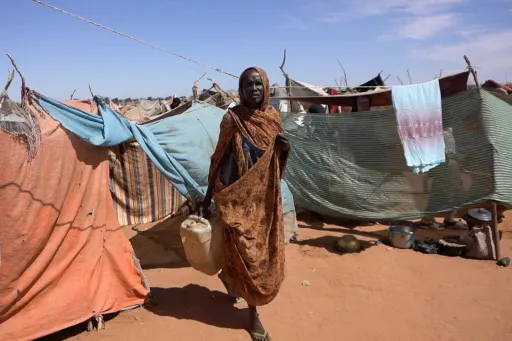By Sylvia Chebet
An antique wooden statue of Ngonnso, venerated in Cameroon as the queen mother of the Nso people, has been sitting in a glass cabinet in German museums for more than a century. The long, agonising wait for this embodiment of spiritual heritage to be returned to where it belongs was to end this year, only for bureaucracy to stall the journey.
As the status quo drags on, dejection seems to be setting in, replacing the excitement that had been building up over Ngonnso's impending return.
"We revere our ancestors. The statue is seen as a connection between the living and our ancestors, and we also use it to invoke fertility of the soil, among other rituals," the Cameroonian restitution activist, Sylvie Vernyuy Njobati, tells TRT Afrika.
"Last February, there was this huge festival, and it was all about bringing people together, and getting ready to welcome Ngonnso. The overwhelming feeling was, how do we start preparing for her coming? This stemmed from the need for a reconnection to ensure that she doesn't come back as an object but as a mother of the people, and play the same role she played before," she recounts.
This was months after – in June 2022, to be precise – that the president of Germany’s Prussian Cultural Heritage Foundation handed Njobati a letter confirming that the life-size statue of Ngonnso would be returned to her people.
For Njobati, the commitment wasn't just the culmination of nearly five years of actively pursuing the return of Ngonnso. It was an emotion-filled vindication of her belief that her people's lost heritage would be restored someday, irrespective of the fact that many before her had tried and failed to accomplish this.
Chequered history
The history of the Nso people found in the Northwest region of Cameroon and their fascination for their queen mother dates back centuries. Following her death, her statue took on great significance, symbolising a cultural cornerstone for the community, whose tradition is built on ancestral worship.
The statue at the heart of the restitution campaign is one among thousands of African artifacts looted from the continent during colonial rule. More than 500,000 of them are now on display in museums across Europe and the US. Many more are part of private collections.
A handful of these items have been restored to their countries of origin. In February 2022, Nigeria welcomed back two statues out of its more than 3,000 Benin Bronzes.
These successes, though few and far in between, inspire Njobati to remain on course, riding the momentum that has gathered steam. She plans to venture into filmmaking in this area, hoping to capture Ngonnso's epic journey of over a thousand miles from Germany to Cameroon, as and when that happens.
Never-ending wait
Despite the promise made by Germany over a year ago, there is still no sign of the sacred statue of Ngonnso returning home anytime soon.
The Nso community expected the wheels to move faster, but inter-state negotiations are still yet to begin. This makes Njobati sceptical of the process.
"It makes no sense for the state to go and have negotiations with another in the absence of the stakeholders, which are the museums and the community. If you show representatives of the state three objects for them to pick Ngonnso, they probably would not even know exactly which one," she rues.
For Njobati, this is a journey of passion and sacrifice. She had made a promise to her grandfather that she would see to it that their queen mother returned to her land.
On the day she held a protest outside the Berlin Museum where the statue of Ngonnso was being displayed, her grandfather died. Distraught as she was at the loss, Njobati resolved to do everything in her power to get her people's spirit guide back home.
"I have come a whole long way. When I entered into these conversations in 2021, there was this general reluctance even to engage with communities on restitution. They (the authorities) just weren't willing to do so," she recalls.
An earlier letter stating that Ngonnso had become the legal property of the Prussian Cultural Heritage Foundation and couldn't be sent back to her people mirrored this reluctance.
But Njobati says she is “happy and satisfied” about how the conversation has evolved since.
“I know things don't happen at once, but I can measure progress, and that is so important. They now acknowledge the violent circumstances and the unethical way of acquisition."
Today, an estimated 40,000 objects from Cameroon are said to be in Germany’s public museums. A research paper, Atlas of Absence, indicates that these objects have hardly been on display, being confined to depots of institutions since the German colonial period (1886–1916).
For the first time, the authors trace the invisible presence of Cameroon in German museums in the article published on arthistoricum.net, an open access publication platform for scholarly e-books on art and history.
Numerous maps, diagrams and photos illustrate the geographical and statistical distribution of the tangible cultural heritage of Cameroon in Germany.
Njobati says two other institutions in Germany have expressed their willingness to return items whose provenance are already clear: 28 from Liden Museum and two from the University of Minds.
“They started acknowledging that these are not just objects to us as Africans, these are our heritage, these are our experiences, these are our essence of being. And so, they moved from 'We cannot restitute' to 'We are willing to work with you', and finally to 'We are willing to restitute," she explains.
Questions about Africa's capacity to preserve its own relics may be contributing to the restitution hesitancy.
In her book, Africa’s Struggle for Its Art: History of a Postcolonial Defeat, the French art historian Bénédicte Savoy argues that the concerns put forward by western museums could be part of an approach to bury demands, delay the process, and lead to capitulation by Africans reclaiming their heritage.
In scrutinizing old correspondences between government officials and museum administrators, Savoy uncovers a dialogue around restitution that is frozen in time.
"Nearly every conversation today about the restitution of cultural property to Africa already happened 40 years ago," she writes.
Before the dawn of museums, historians say Africans lived and interacted with their objects for centuries without losing their “value or meaning.”
Local ways of preservation kept the physical properties intact to a great extent, ensuring they were never really destroyed.
“The only challenge at this point is that Ngonnso has gone through a chemicalised form of preservation, and is probably dependent on this to retain its properties, shape and form," says Njobati.
She hastens to add that there is no cause for alarm. More importantly, she says, objects like these belong in the royal palaces from where they were looted.
What isn't clear yet is how long Njobati and her Nso people will have to wait for the return of Ngonnso, their spirit guide. But as and when the queen mother touches down, expect no less than an exultant cry of triumph from a civilisation's soul.
























